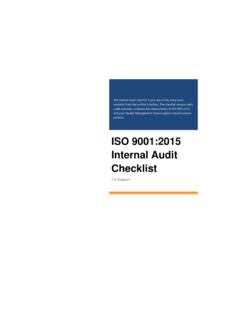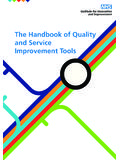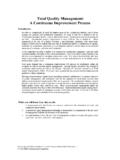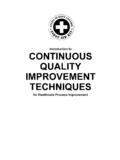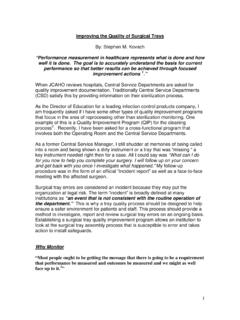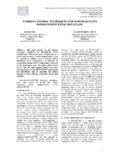Transcription of ISO 9000:2001 - Do Your Quality Objectives Deliver …
1 Do your Quality Objectives Deliver real results ? Welcome Thank you for downloading our Quality Objectives white paper which will help you understand their importance to your business model. Quality Objectives are not static and need to be updated to meet business conditions. There is clearly a link between revising the Quality policy and Objectives and the organisation's commitment to continual improvement, especially when continual improvement is best measured in monetary terms.
2 The importance of poor- Quality cost was recognized by the US Department of Defense when a requirement for PQC systems was included in Military Standard MIL-Q-9858A. ISO 10014 is an existing ISO Standard on the Economics of Quality . I feel it is only a matter of time before ISO 9000 also includes PQCs (poor- Quality cost) as a key driver of continual improvement. In fact, I'm willing to bet that PQC will feature in the next revision to ISO 9000, whenever it's published. Follow this link to the ISO 9001 Audit Practices Group and learn more about modern audit techniques.
3 The leading UK Certification Bodies NQA and Lloyds Register Quality Assurance both provide free, and useful information on 21st Century Quality thinking. To your success! Stephanie Keen Managing Partner, ISO Navigator Management Systems Introduction I believe that all managers are committed to Quality - ask them, and they will tell you it is true, however, it is sometimes difficult to ascertain to what, specifically, they are committed and this point is at the heart of the problems associated with implementing ISO 9001.
4 2008 Top management did not define ' Quality ' in relation to the business ( Quality policy) Top management did not act to ensure that Quality is achieved ( Quality Objectives ) your Quality Policy the only true definition of Quality The reason you need to define ' Quality ' is this: if you don't know what it is, you'll never know whether you've achieved it. Not knowing where you want to get to makes it impossible to communicate to other people what is to be achieved and why, let alone motivate them to act.
5 Do your Quality Objectives Deliver real results ? There are many formal definitions of Quality - for all practical purposes you can ignore all of them. The only definition of Quality that counts is the one on which you and your colleagues agree. The agreed Quality policy should be the driving force of the system and commits the organisation to both meeting requirements and improvement. It is one of the key documents against which the performance of the Quality system is audited.
6 You are required to ensure that you continually improve the degree to which your products and services meet customer requirements effectiveness of your processes ( improved results ) perceptions of your customers as to how well their requirements have been met Continual improvement is not some special form of improvement. The continual improvement principle implies that you: adopt the attitude that improvement is always possible develop the skills (such as looking for causes of problems) and the tools (like simple charts and graphs) to be able to improve systematically always know what must improve next and how you will measure the improvement Provided you take into account the few important items ISO 9001 asks for, you can define and measure Quality any way you choose.
7 And once you have a set of Objectives that suits you and your customers, you can drop the vague word ' Quality ' and focus your energies and your system on achieving your Objectives . Quality Objectives The translation of the Quality policy into practice is made by defining supporting Objectives but ISO 9001 does not specify how Quality Objectives are documented: they may be documented in business plans, management review output, annual budgets, etc. Quality Objectives are now a clear requirement in their own right as opposed to being just a part of Quality policy.
8 They must be established, support the policy, be measurable and focus on both meeting product requirements and achieving continual improvement. When your Quality Objectives are defined they must reflect the Quality policy, be coherent, and align with the overall business Objectives , including customer expectations. In short, ISO 9001 Quality Objectives must Deliver a meaningful result and therefore Quality Objectives equal Business Objectives . Surely the objective of any organisation (either commercial or not-for-profit) is to use their money wisely?
9 Quality Objectives and the Cost of Poor Quality ISO 9004:2000 Para. Financial Resources recommends that: Management should plan, make available and control the financial resources necessary to achieve the organization s Objectives and encourage improvement of the organization s performance. Do your Quality Objectives Deliver real results ? Improving the effectiveness and efficiency of the Quality management system can influence positively the financial results of the organization, for example a) Internally, by reducing process and product failures, or waste in material and time, or b) Externally, by reducing product failures, costs of compensation under guarantees and warranties, and costs of lost customers and markets.
10 Reporting of such matters can also provide a means of determining ineffective or inefficient activities, and initiating suitable improvement actions. The History of Quality Costing The original Quality -cost concept was developed by Armand V. Feigenbaum while working at General Electric in the 1940s. He called his new reporting system cost of Quality Basically; it tallied the costs related to developing a Quality system and inspecting products, as well as the cost incurred when a product failed to meet requirements.

